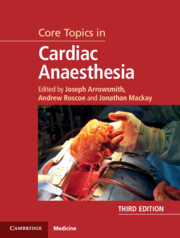Book contents
- Core Topics in Cardiac Anaesthesia
- Core Topics in Cardiac Anaesthesia
- Copyright page
- Dedication
- Contents
- Contributors
- Reviews of the First Edition
- Preface to the Third Edition
- Preface to the First Edition
- Foreword to the First Edition
- Abbreviations
- Section 1 Routine Cardiac Surgery
- Section 2 Anaesthesia for Specific Procedures
- Section 3 Cardiac Catheter Laboratory Procedures
- Section 4 Paediatric Cardiac Surgery
- Section 5 Cardiopulmonary Bypass
- Section 6 Advanced Monitoring
- Chapter 30 Cardiovascular Monitoring
- Chapter 31 Neurological Monitoring
- Section 7 Transoesophageal Echocardiography
- Section 8 Miscellaneous Topics
- Index
- References
Chapter 31 - Neurological Monitoring
from Section 6 - Advanced Monitoring
Published online by Cambridge University Press: 12 May 2020
- Core Topics in Cardiac Anaesthesia
- Core Topics in Cardiac Anaesthesia
- Copyright page
- Dedication
- Contents
- Contributors
- Reviews of the First Edition
- Preface to the Third Edition
- Preface to the First Edition
- Foreword to the First Edition
- Abbreviations
- Section 1 Routine Cardiac Surgery
- Section 2 Anaesthesia for Specific Procedures
- Section 3 Cardiac Catheter Laboratory Procedures
- Section 4 Paediatric Cardiac Surgery
- Section 5 Cardiopulmonary Bypass
- Section 6 Advanced Monitoring
- Chapter 30 Cardiovascular Monitoring
- Chapter 31 Neurological Monitoring
- Section 7 Transoesophageal Echocardiography
- Section 8 Miscellaneous Topics
- Index
- References
Summary
Monitors of neurological function have been available since the 1950s. Until recently, however, many have remained in the hands of enthusiasts at academic centres. Many laboratory methods are not readily adaptable for intraoperative use or cannot be practically used routinely because of cost or the need for expert interpretation. The invasive nature of other monitors (e.g. cerebral microdialysis) precludes their use in the setting of systemic anticoagulation. Emerging evidence suggests that modern neuromonitoring technologies – particularly when used together – can be used both to predict and to modify clinical outcome.
- Type
- Chapter
- Information
- Core Topics in Cardiac Anaesthesia , pp. 230 - 238Publisher: Cambridge University PressPrint publication year: 2020



